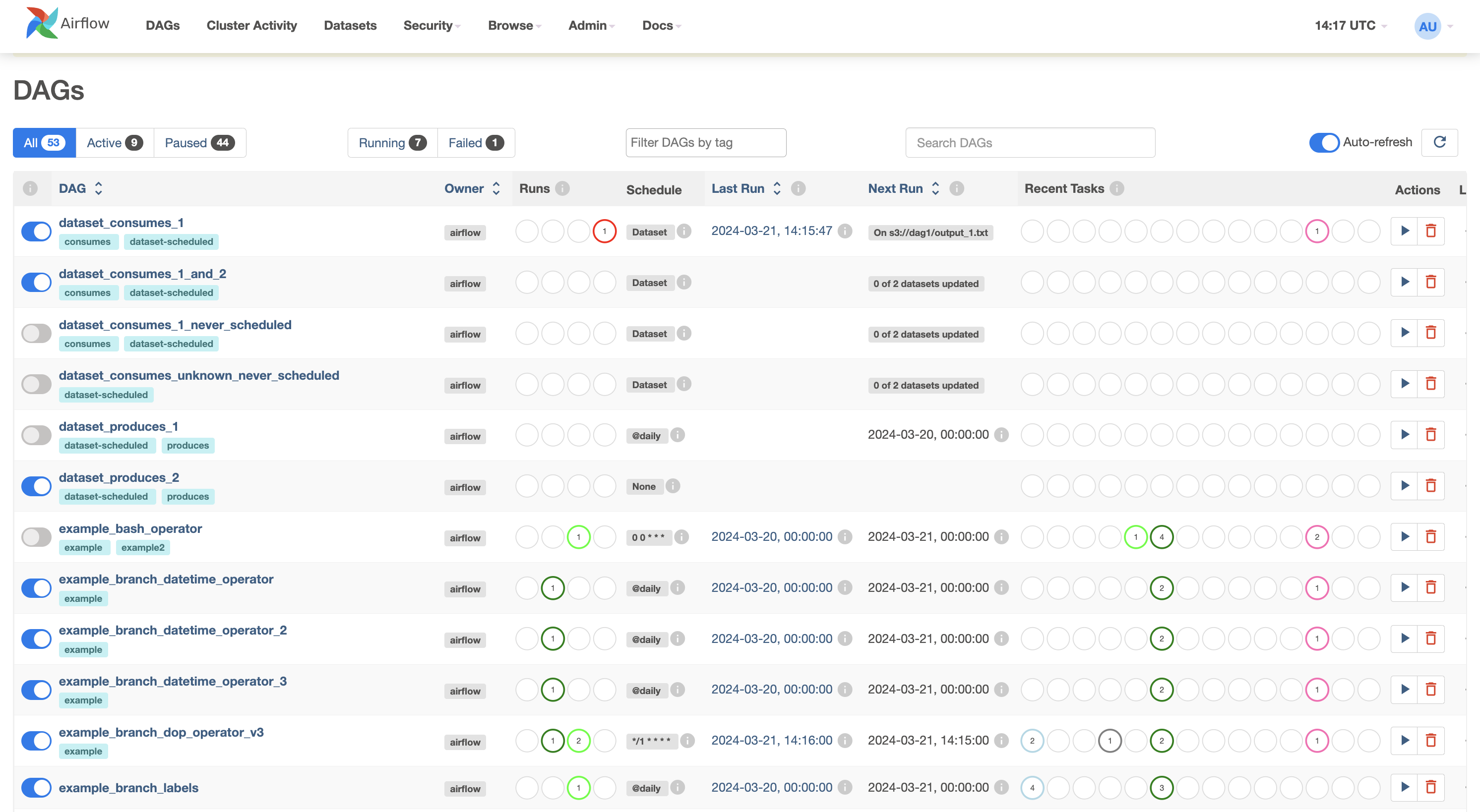Airflow
docs: https://airflow.apache.org/docs/apache-airflow/stable/index.html
Apache Airflow is a platform used to programmatically author, schedule, and monitor workflows. It allows you to define complex workflows as directed acyclic graphs (DAGs) and execute them on a scheduled basis or triggered by events.
A DAG is the core concept in Airflow. It's a collection of tasks and their dependencies, organized as a directed acyclic graph. Example:
from datetime import datetime
from airflow import DAG
from airflow.operators.python_operator import PythonOperator
def build_task():
pass
def test_task():
pass
def dynamic_workflow():
dag = DAG(
f'dynamic_workflow',
start_date=datetime.now(),
schedule_interval=None,
catchup=False,
)
build = PythonOperator(
task_id=f'build',
python_callable=build_task,
op_args=[],
dag=dag,
)
test = PythonOperator(
task_id=f'test',
python_callable=test_task,
op_args=[],
dag=dag,
)
# Set task dependencies
build >> test
return dag
dynamic_workflow()
- Airflow uses schedulers and executors to manage task execution. The scheduler determines when to execute tasks,
while the executor defines how tasks are run.
- Airflow supports various executors:
- https://airflow.apache.org/docs/apache-airflow/stable/core-concepts/executor/index.html#executor-types
- local ones: e.g. SequentialExecutor, LocalExecutor
- remote ones: e.g. CeleryExecutor, CeleryKubernetesExecutor, KubernetesExecutor
- allows dynamic pipelines generation
- sensors: type of operators designed to wait for something to occur:
- https://airflow.apache.org/docs/apache-airflow/stable/core-concepts/sensors.html
It can be time-based, or waiting for a file, or an external event, but all they do is wait until something happens, and then succeed so their downstream tasks can run.
- these look like a good fit for waiting for a message from messaging bus
- https://airflow.apache.org/docs/apache-airflow/stable/core-concepts/sensors.html
- provides UI

- from
Why notin docs:Airflow™ was built for finite batch workflows. While the CLI and REST API do allow triggering workflows, Airflow was not built for infinitely running event-based workflows. Airflow is not a streaming solution. However, a streaming system such as Apache Kafka is often seen working together with Apache Airflow. Kafka can be used for ingestion and processing in real-time, event data is written to a storage location, and Airflow periodically starts a workflow processing a batch of data.
CeleryExecutor
Details: https://airflow.apache.org/docs/apache-airflow/stable/core-concepts/executor/celery.html
- it is also possible to use Flower UI
CeleryKubernetesExecutor
allows users to run simultaneously a CeleryExecutor and a KubernetesExecutor. An executor is chosen to run a task based on the task’s queue.
Details: https://airflow.apache.org/docs/apache-airflow/stable/core-concepts/executor/celery_kubernetes.html (also see the section when to use)
KubernetesExecutor
- each task run in its own pod
- scheduler itself does not necessarily need to be running on Kubernetes, but does need access to a Kubernetes cluster
Details: https://airflow.apache.org/docs/apache-airflow/stable/core-concepts/executor/kubernetes.html
Deployment
- the architecture is more complex, there are multiple components: scheduler, webserver, executor, db, ..
- example of running in Docker: https://airflow.apache.org/docs/apache-airflow/stable/howto/docker-compose/index.html
- production deployment: https://airflow.apache.org/docs/apache-airflow/stable/administration-and-deployment/production-deployment.html
- provides Docker images: https://airflow.apache.org/docs/docker-stack/index.html
- provides Helm charts